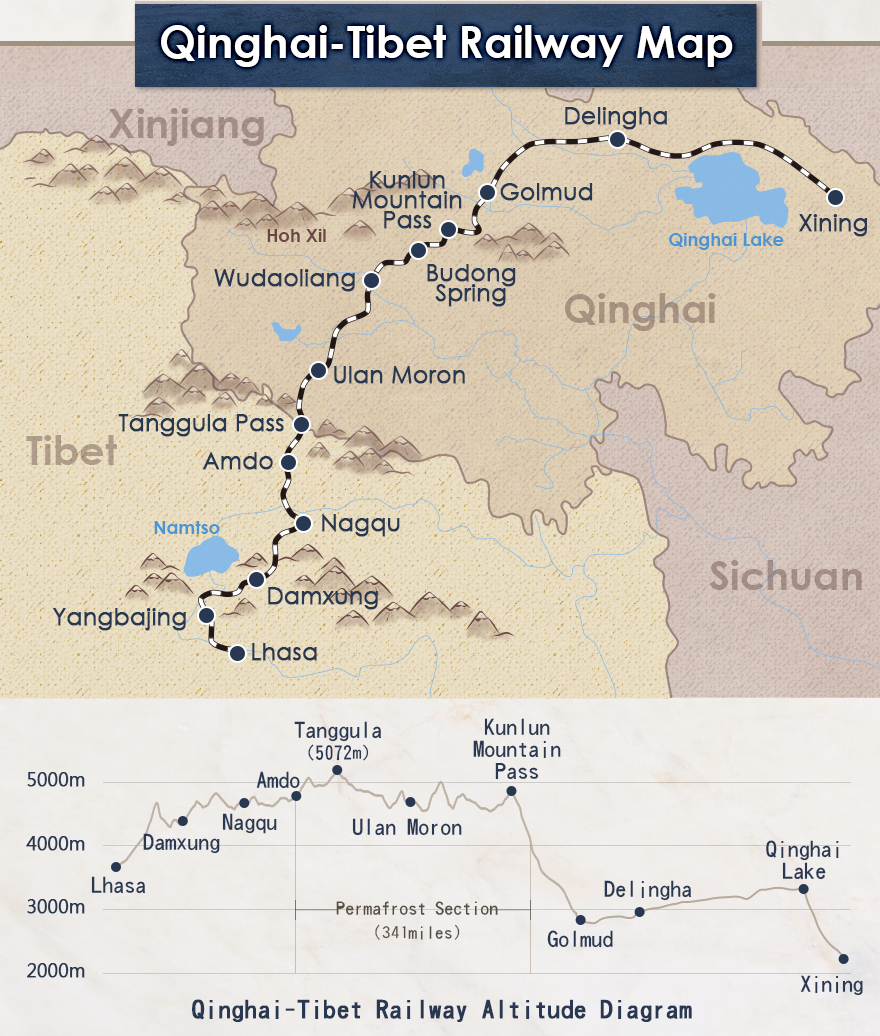In lofty realms where heavens meet the Earth,
There stands a peak that claims the sky's rebirth.
At dawn's first blush, your crown gleams gold,
A shimmering jewel, an allure untold.
Mount Everest, majestic, in Tibet's embrace,
A testament to nature's sovereign grace.














The journey from Xining to Lhasa is about 21 hours. To help our guests travel more comfortably, we arrange soft sleepers with 4 guests per room. Due to limited conditions onboard and difficulties in obtaining tickets, however, it is possible that we share a room with other passengers.


The Qinghai-Tibet train passes through stunning sections of landscape and wildlife ranging from snow-capped mountains to bright green plains (landscape seen during the day varies depending on train departure time, weather conditions, etc.):








(Guests on our 8-day tour return home today while guests on our 12-day tour continue to Mt. Everest base camp)



This is a very high altitude trip and it is important to take time to acclimate. From the moment you step on the Tibetan plateau, please remember: slow, slow, slow. Walk slowly, talk slowly, and breathe slowly. Mild headache, dizziness, vomiting, etc. are normal symptoms of high altitude; conditions will usually improve slowly over a few days. If symptoms become serious, please inform our guide immediately.
*Before you leave, please consult your physician and prepare an appropriate prescription medication to alleviate possible reactions to high altitude, making your trip more enjoyable and exciting. Diamox pills are not commonly sold in Tibet.
The Sofitel Xining blends romantic style with elegance and is the only platinum five-star luxury hotel in Northwest China. From fresh floral arrangements in French style, French artwork to French music, the French art of living is combined with Chinese hospitality traditions to create a noble and elegant atmosphere.
|
Deluxe Room
|
40 m² (431 ft²)
|
|
120 x 200 cm * 2 Bed
|
180 x 200 cm * 1 Bed
|
The Tibet Train represents a remarkable achievement in engineering and has become an iconic symbol of human ingenuity and perseverance. It serves as a gateway to one of the most extraordinary and enchanting regions in the world, providing an unforgettable travel experience for all who embark on this extraordinary railway adventure.
Our guests can enjoy soft sleepers with panoramic views from large windows, witnessing the awe-inspiring landscapes unfold before their eyes. The journey offers a chance to immerse oneself in the rich Tibetan culture, interact with the friendly locals, and gain a deeper appreciation for the region's unique way of life.
With its prime location in Lhasa, the Shangri-La Hotel is an ideal base for exploring the city's cultural treasures, including the magnificent Potala Palace, Jokhang Temple, and Barkhor Street. After a day of exploration, you can retreat to the hotel's serene ambiance and soak in the majestic beauty that surrounds you.
|
Deluxe View Room
|
43 m² (463 ft²)
|
|
120 x 200 cm * 2 Bed
|
180 x 200 cm * 1 Bed
|

Lhadar was great & Vincent was amazing. Vincent's attitude was awesome & he went above and beyond to see our comfort as well as make our trip unforgettable. Lhadar was so good at explaining everything we saw & he answered all the questions we had along the way. This trip was really fantastic & I can't imagine another company doing it as well. I also appreciated all the small comforts along the way like masks, snacks, neck pillow, toilet liners, toilet paper, etc. It showed attention to detail that we would not have anticipated.

We had a spectacular trip. It was a trip of a lifetime. Got to see Everest too (the clouds opened up just for us). Everything went really. We even handled the altitude with no issues. As usual, Super Value Tours did an amazing job (great guides, hotels, food, service, and itinerary). Thank you for all of your help to make this trip happen for us!

Tutu, our tour manager for the Tibet Tour was exceptional. She was smart, efficient, organized, energetic but also warm and caring, cheerful, and unfailingly helpful... She was quite a special person.
Before departure, learn more about altitude sickness, local customs and culture, and Tibet Travel. With these basic concepts in mind, you can quickly adapt to the local area, and you will definitely have a wonderful and unforgettable time!
◈ Information About Altitude Sickness
Altitude sickness generally refers to the reaction of the human body in high altitude areas (8000-9000 ft above sea level). Because of low pressure, high radiation, lack of oxygen, high cold and other climate characteristics, each person may have different reactions. Common reactions are headaches, dizziness, insomnia, nausea and vomiting, loss of appetite, exhaustion and weakness. Not to worry though, with proper preparation and precautions, these symptoms will gradually decrease or disappear after 1-2 days.
Populations at higher risk of developing high-altitude disease
Due to the special environment and the remoteness of most high-altitude areas, medical resources are less accessible. Those suffering from heart failure, pulmonary hypertension, chronic obstructive pulmonary disease (COPD), myocardial hypoxia (angina), sickle anemia, any type of pulmonary dysfunction and high-risk pregnant women should first consult a physician if high altitude activities are safe.
Prevention and response to altitude sickness
◈ Local customs and culture
◈ Travel in Tibet





